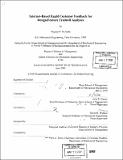| dc.contributor.advisor | John R. Hauser and David R. Wallace. | en_US |
| dc.contributor.author | McArdle, Meghan P. (Meghan Patricia), 1972- | en_US |
| dc.contributor.other | Massachusetts Institute of Technology. Dept. of Mechanical Engineering. | en_US |
| dc.date.accessioned | 2005-09-27T19:44:19Z | |
| dc.date.available | 2005-09-27T19:44:19Z | |
| dc.date.copyright | 2000 | en_US |
| dc.date.issued | 2000 | en_US |
| dc.identifier.uri | http://hdl.handle.net/1721.1/8990 | |
| dc.description | Thesis (S.M.)--Massachusetts Institute of Technology, Sloan School of Management; and, (S.M.)--Massachusetts Institute of Technology, Dept. of Mechanical Engineering, 2000. | en_US |
| dc.description | Includes bibliographical references (p. 86-88). | en_US |
| dc.description.abstract | In an increasingly competitive consumer products market, companies are striving to create organizations, processes, and tools to reduce the product development cycle time. As product development teams strive to develop products faster and more effectively, incorporating quantitative market research or customer feedback into the design process in a time and cost effective manner becomes increasingly important. Over the last decade, the Internet has emerged as a new and exciting market research medium, which can provide product development teams with an opportunity to obtain rapid quantitative feedback from their customers before making key design decisions. This paper outlines a new methodology to incorporate customer feedback into the feature selection process of product development. This methodology was successfully employed in a new product development effort at Polaroid, and aided in the selection of 2 key product features. The research employed web-based conjoint analysis techniques and an innovative drag and drop technique, which allows customers to create their ideal product by selecting their optimal set of features at a given price. Leveraging the capabilities of the Internet to incorporate styled web design, animation, interactive activities and usability considerations into the development of an Internet-based, market research effort can reduce respondent fatigue and provide the respondent with a more enjoyable experience while collecting meaningful quantitative data on customer feature preferences. | en_US |
| dc.description.statementofresponsibility | by Meghan P. McArdle. | en_US |
| dc.format.extent | 105 p. | en_US |
| dc.format.extent | 20448191 bytes | |
| dc.format.extent | 20447953 bytes | |
| dc.format.mimetype | application/pdf | |
| dc.format.mimetype | application/pdf | |
| dc.language.iso | eng | en_US |
| dc.publisher | Massachusetts Institute of Technology | en_US |
| dc.rights | M.I.T. theses are protected by copyright. They may be viewed from this source for any purpose, but reproduction or distribution in any format is prohibited without written permission. See provided URL for inquiries about permission. | en_US |
| dc.rights.uri | http://dspace.mit.edu/handle/1721.1/7582 | |
| dc.subject | Sloan School of Management. | en_US |
| dc.subject | Mechanical Engineering. | en_US |
| dc.title | Internet-based rapid customer feedback for design feature tradeoff analysis | en_US |
| dc.type | Thesis | en_US |
| dc.description.degree | S.M. | en_US |
| dc.contributor.department | Massachusetts Institute of Technology. Department of Mechanical Engineering | |
| dc.contributor.department | Sloan School of Management | |
| dc.identifier.oclc | 47261040 | en_US |
